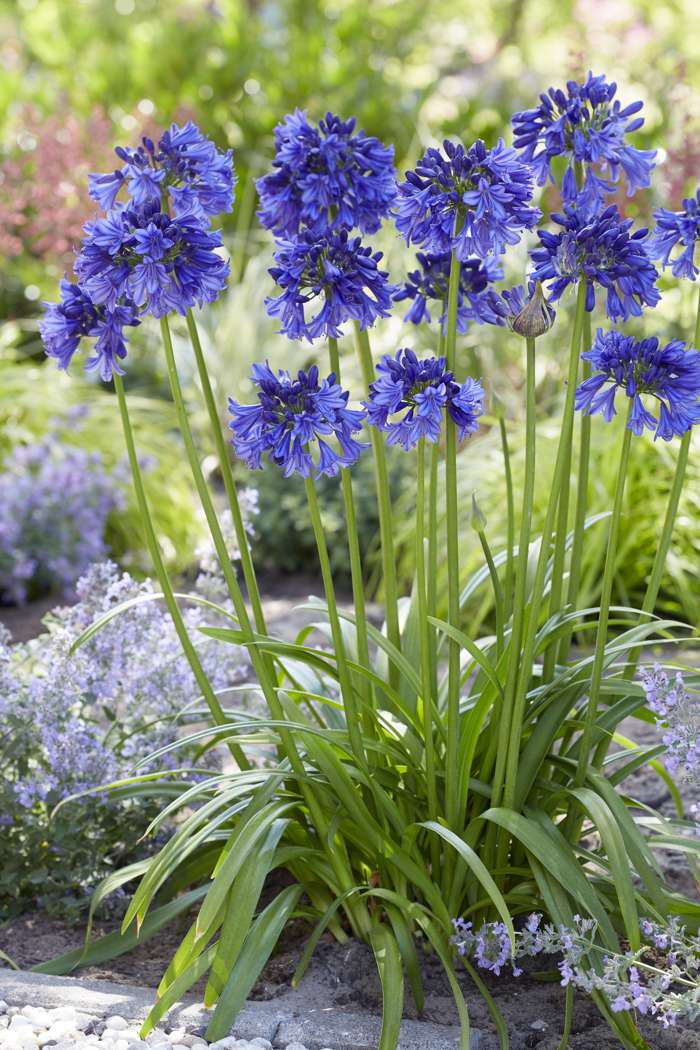Agapanthus Treatment Tips for Lush and Vibrant Flowers
Agapanthus Treatment Tips for Lush and Vibrant Flowers
Blog Article
Letting Loose the Secret to Effective Agapanthus Cultivation: Tips and Techniques for a Flourishing Yard
In the realm of horticulture, growing agapanthus efficiently needs a calculated approach that encompasses numerous facets of plant care. By recognizing the nuances of agapanthus cultivation, one can produce an environment where these plants flourish and grow abundantly.
Planting Agapanthus: Best Practices
When planting Agapanthus, appropriate dirt preparation is necessary for ensuring successful growth and advancement of these attractive blossoms. Agapanthus, commonly called Lily of the Nile or African lily, prospers in well-draining dirt with a somewhat acidic to neutral pH degree - Agapanthus. Prior to planting, it is critical to modify hefty clay dirts with organic issue such as garden compost or peat moss to enhance water drainage and supply vital nutrients for the plants
To grow Agapanthus, pick an area that receives full sunshine to partial shade, as this will promote healthy growth and plentiful flowering. Dig an opening twice the diameter of the plant's origin round and place the Agapanthus at the same depth it was previously growing. Carefully backfill the opening with dirt, pushing down securely to eliminate any type of air pockets around the origins.
Water the recently grown Agapanthus thoroughly and remain to maintain the soil evenly moist, particularly throughout the plant's energetic expanding season. Agapanthus. Applying a balanced plant food once a month can additionally support the plant's development and blooming. By following these ideal techniques for growing Agapanthus, you can create a sensational display screen of these fascinating flowers in your garden
Suitable Soil Issues for Agapanthus
For optimum growth and growing success of Agapanthus plants, making certain the dirt conditions are perfect is vital. Agapanthus chooses dirt that is rich in nutrients, so integrating a well balanced fertilizer throughout the growing period can advertise healthy development and dynamic blossoms.

Watering and Fertilizing Tips
To make sure healthy growth and vivid blossoms, appropriate watering and fertilizing methods are essential for effective Agapanthus growing. Agapanthus plants benefit from routine watering, especially during the expanding period.
When it concerns feeding Agapanthus, a balanced plant food with equal components nitrogen, phosphorus, and potassium can be used in the spring to promote healthy and balanced development and blooming. Slow-release fertilizers are ideal for supplying nutrients progressively over an extended duration. Prevent over-fertilizing, as this can lead to too much vegetation development at the cost of blooms.
Additionally, including raw material like garden compost right into the dirt can improve nutrient levels and boost soil structure, helping in the general health and wellness of the Agapanthus plants. By complying with these watering and fertilizing tips, garden enthusiasts can guarantee their Agapanthus plants prosper and generate stunning screens of flowers.
Trimming and Deadheading Strategies
Appropriate trimming and deadheading strategies play an important role in maintaining the health and aesthetic appeals of Agapanthus plants, Full Report complementing the necessary techniques of watering and fertilizing for effective cultivation. Trimming Agapanthus involves eliminating spent flower heads, yellowing or dead leaves, and overall shaping of the plant to promote far better development. Deadheading, the process of removing discolored flowers, not just enhances the plant's look but also motivates more blooming.
When deadheading Agapanthus, it is a good idea to snip off the flower stem at the base utilizing sharp, tidy shears. This process redirects the plant's power from seed manufacturing back right into origin and vegetation development, advertising a healthier and more robust plant. Regular deadheading can prolong the blooming period of Agapanthus and protect against self-seeding, which can result in congestion.
In terms of trimming, Agapanthus generally take advantage of a light trim after flowering to clean up the plant and encourage fresh growth. Cutting back the invested blossom stems and getting rid of any kind of broken or dead vegetation helps keep the plant's vitality and total appearance. However, it is vital to stay clear of reducing into the crown of the plant, as this can deteriorate its blog health and wellness.

Protecting Agapanthus From Pests and Diseases
Carrying out efficient parasite and disease management approaches is essential to guarding the health and vitality of Agapanthus plants in growing. Agapanthus are typically hardy plants, yet they can still succumb to numerous insects and illness if not effectively taken care of. One common bug that affects Agapanthus is the Agapanthus borer, a caterpillar that tunnels into the plant, causing damage to the leaves and flowers. To avoid problems, normal examination of the plants is Full Report important. If borers are found, they can be manually removed, or insecticidal soap can be made use of as a control procedure.
In addition to pests, Agapanthus are prone to diseases such as origin rot and fungal fallen leave areas. By staying watchful and resolving pest and illness concerns quickly, gardeners can aid their Agapanthus grow and flourish.

Verdict
Finally, effective farming of agapanthus needs proper growing strategies, ideal soil problems, ample watering and feeding, regular trimming and deadheading, and security from conditions and bugs. By complying with these tricks and ideas, garden enthusiasts can make certain a growing garden filled with gorgeous agapanthus blooms. Agapanthus. Remember to maintain constant care and focus to information to promote the health and longevity of these spectacular plants
When growing Agapanthus, appropriate dirt preparation is vital for guaranteeing effective growth and advancement of these attractive blossoms.Water the recently planted Agapanthus extensively and continue to maintain the dirt uniformly wet, specifically during the plant's active expanding season.For ideal growth and blooming success of Agapanthus plants, making sure the dirt conditions are excellent is vital. When hair transplanting or growing Agapanthus, guarantee the dirt is well-prepared to give the necessary foundation for the plants to establish themselves efficiently. One usual parasite that affects Agapanthus is the Agapanthus borer, a caterpillar that passages right into the plant, causing damages to the fallen leaves and blossoms.
Report this page